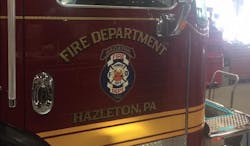PA Firefighters Issue Warning after Carbon Monoxide Death
Nov. 22--When Hazleton firefighters arrived at the scene of a tragic carbon monoxide incident Sunday, initial readings showed gas levels at a deadly 500 parts per million.
The high concentration of the colorless, odorless gas took the life of Carlos A. Minaya Castillo, 49, who died in the basement of his 692 Alter St. home.
An investigation revealed that Castillo died after leaving his vehicle running in the home's attached garage.
Firefighters and an area plumber noted that anything that burns fuel can produce carbon monoxide, and it becomes dangerous if it's not vented in a proper way.
According to OnHealth.com, "The health effects of CO depend on the level of CO and length of exposure, as well as each individual's health condition. The concentration of CO is measured in parts per million (ppm). Health effects from exposure to CO levels of approximately 1 to 70 ppm are uncertain, but most people will not experience any symptoms. Some heart patients might experience an increase in chest pain. As CO levels increase and remain above 70 ppm, symptoms may become more noticeable (headache, fatigue, nausea). As CO levels increase above 150 to 200 ppm, disorientation, unconsciousness, and death are possible."
Castillo's accidental death should remind residents to protect themselves against what's known as the "silent killer," Hazleton Fire Chief Donald Leshko said.
"Carbon monoxide poisoning can prevent the body from getting oxygen, and can cause flu-like symptoms such as nausea, headache and dizziness, shortness of breath, sleepiness and weakness. In large amounts, carbon monoxide can cause loss of consciousness, brain damage or death. By knowing more about carbon monoxide poisoning prevention, you can protect yourself and your family," Leshko said in a news release.
"We need to learn from this tragic incident and make sure every home has a working carbon monoxide detector along with working smoke alarms."
Leshko noted that carbon monoxide can come from furnaces, wood stoves, kerosene heaters, generators, gas-powered home appliances, gas-powered tools, gas and charcoal grills, and cars and trucks.
Ron Marchetti, of Marchetti Plumbing in Hazleton, said it's recommended that folks have their home heating systems serviced annually.
"Especially if they have coal," Marchetti said. Coal can produce fly ash and soot, which can cause blockages in furnaces, he said.
Oil burners should have filters, nozzles and other parts cleaned or replaced every year. Gas furnaces manufactured over the past several years usually won't light if there's a blockage in the chimney, he said.
Marchetti said he checks chimneys for blockages when he's servicing heating units and recommends chimney cleaning if needed.
Leshko said homeowners should install carbon monoxide detectors on all floors and within 10 feet of the entrances to bedrooms. Also:
- Carbon monoxide detectors should be certified by Underwriters Laboratories (UL). Carefully follow the instructions for installation, use, maintenance and replacement.
- Use battery-operated or plug-in electric carbon monoxide detectors. If you choose to install an electric carbon monoxide detector, it must have a battery backup and it can't be connected to an outlet controlled by a wall switch. Check your detector batteries twice a year.
- Check the date on your alarm; they are typically good for five to seven years but some are now good for 10 years. Always refer to the manufacturer's recommendations.
- If the alarm sounds, get out of the building and into fresh air.
Residents are reminded:
- Never use a generator or other gasoline-powered equipment, including portable flameless catalytic heaters, inside your home or garage, basement or any enclosed or semi-enclosed space even if doors and windows are open. Operate portable generators outdoors and downwind of buildings. The Centers for Disease Control and Prevention recommends a distance of at least 25 feet from the house window, door or vent.
- Never use a gas range or oven for warmth.
- Never use a charcoal grill or a barbecue grill in your home or garage.
- Never start up or run any gasoline-powered engines (snow blowers, generators, mowers, weed trimmers, chain saws or other small motors) in enclosed spaces.
- Ensure that heating systems and appliances are installed and serviced annually by qualified professionals. Never use a stove or fireplace unless it is properly installed and vented. Don't patch vent pipes in your home, cabin, camper, boat or workplace with tape or gum. When renovating a home or repairing a roof, make sure that tarps or debris do not block vents and chimneys.
- Never run your car or truck or motorcycle inside a garage that is attached to a house or in a detached garage even if the garage door is open. Remove vehicles from a garage immediately after starting them, even if the garage door is open.
If you open the tailgate on a running sport utility vehicle or similar vehicle, open the vents/windows to ensure air flow and exchange. Ensure that vehicle exhaust pipes are not blocked in or after a heavy snowstorm. Make sure vents for the furnace, stove, fireplace and dryer are clear of snow.
If you suspect carbon monoxide poisoning and your carbon monoxide detector activates:
- Open all windows and doors and get out of the building and into the fresh air.
- Dial 911 if your heating unit uses natural gas; call the gas company from outside the building.
- Dial 911 if you or someone else is experiencing symptoms, or take the ill person to the emergency room and tell the doctor you suspect carbon monoxide poisoning.
___ (c)2017 the Standard-Speaker (Hazleton, Pa.) Visit the Standard-Speaker (Hazleton, Pa.) at standardspeaker.com Distributed by Tribune Content Agency, LLC.
